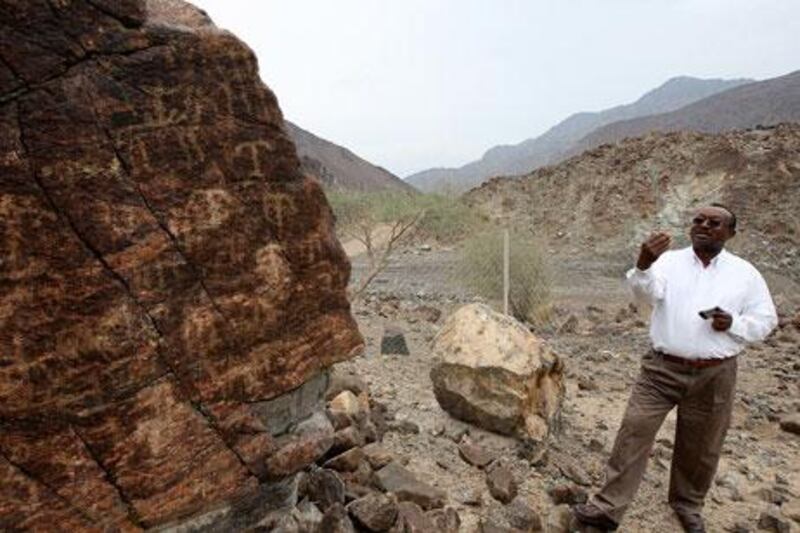FUJAIRAH // Some are mere scratches on a rock surface, others depict indigenous animals, such as camels, hyaenas and leopards. There are human stick figures too, some riding horses, others engaged in battle.
These rare ancient petroglyphs, or rock art, can be found scattered across the mountainous terrains of the UAE, in Fujairah, Ras al Khaimah and Hatta, and across other parts of the Arab world.
These treasures are thousands of years old and are believed to date back to the Iron age, between 1300BC to 300BC, with some from the late pre-Islamic period. However, they are disappearing at an alarming rate as more road and rock-crushing projects take over the mountains.
"They should be taken more seriously and treated like national treasures," said Salah Ali Hassan, who has been the resident archaeologist at Fujairah Museum since it opened in 1991.
"While we may not know the exact meaning behind them, they are beautiful, and are rare paintings from the past."
_________________________________
MORE
What rock art means to UAE locals
_________________________________
Mr Hassan and his associate, Dr Michele Ziolkowski, have rescued hundreds of petroglyphs from the deepest valleys in Fujairah alone. They brought the smaller ones into the museum and fenced off the larger versions so they would be protected from construction projects.
But their efforts are not enough, which is why Mr Hassan is planning to raise the issue of rock art at an upcoming archeology symposium in Al Ain in March.
The team is hoping the issue of protecting them can be taken up "nationally".
"Raising awareness about them at the national level is critical for their survival," Mr Hassan said.
"When they were first discovered in the late 1980s, they were hard to get to, and it would take days to reach any of them," he said. "But now, with roads cut into the mountains, they are more accessible. That is both good and bad. They should be carefully opened up to visitors who are interested in rock art and turned into touristic sites."
The threat to petroglyph sites was made more urgent last week when it was announced that manufacturing plants and garages in Fujairah city would be moved to an expanded industrial zone near Wadi al Hayl, an area of Fujairah that contains more than 100 petroglyphs.
Dr Ziolkowski, who has been documenting the petroglyphs to a large extent on her own, is hoping for national co-operation.
"The first step is to create a national database of all the rock-art sites, where the experts should be allowed to go to a site and survey it before construction begins to protect and mark the petroglyphs," she said.
For now, fences built around the pieces of history have helped protect many of them against destruction, but a long-term solution has to be enforced, explained Dr Ziolkowski.
"Who will make sure that mistakes are not made on a construction site where all these bulldozers and dynamites around?" she said.
The motifs on display at the museum include clear, deep etchings, such as Wadi al Hayl's dotted hyaena drawn over a one-metre long solid rock. Just beyond al Farfar village in Wadi Saham, 45 minutes away past a series of cordoned-off prehistoric burial sites, stands one impressive isolated petroglyph in its original setting.
The panel depicts what appears to be a battle or hunting scene. Some figures bear missing or exaggerated features - they may have giant fingers or an oversized head - suggesting they represent a "godly like figure".
Some experts suggest they represent a lost language or provide simply directions to another location. They may be historic records of legendary figures and battles or evidence of cults.
"We can't say anything for certain," said Mr Hassan. "This is a relatively new area of study, and so rock art needs more research and dedication."
There are about 60 known rock-art sites in the Emirates, with many believed to have already been lost due to quarries and construction.
Several years ago when a road was being planned through an area called Hassat al Risoom, which translates to "rock with drawings", the locals objected and had the project stopped.
"When people found out they will be losing their ancestor's petroglyphs, they reacted. So that is what we need, on a national level," Dr Ziolkowski said.





